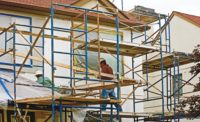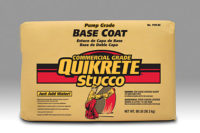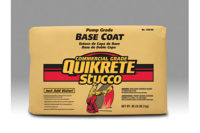We all know that stucco has been around since the Pharaohs walked the earth and that our modern stucco claddings are an engineered mix of cement, sand and lime applied in a three coat process. The three-coat stucco process was established as the standard, successfully cladding buildings for many years. Throughout the ’50s and ’60s, home construction began to transition from a block and brick structure to the quicker, more affordable wood framing. In the Sunbelt areas of the United States, the wood frame and three coat stucco cladding became popular. Stucco afforded a cost effective and architecturally flexible home. It was faster, easier and more cost effective to make quoins, pop-outs, wainscots and window wraps out of three coat stucco, compared to brick and mortar or wood.
LOOKING BACK
In the early-70s, the housing market was rapidly extending into the suburbs where neighborhood developments began to form. The demand for these developments was ever increasing and homes were being built faster than before. The popular three coat stucco cladding was becoming a time anchor inhibiting the supply of the popular stucco house. Thus was born one-coat stucco. The most prolific, at that time, and relative first comer, was a bagged product called Powerwall. An enterprising salesman selling surface bonding cement for Barrett Industries in Florida was presented with a challenge: find or develop a cost effective stucco cladding. This author looks back and can point to that young salesman named Bill Nichols as the first successful and most prolific inventor, manufacturer and subsequent distributor of what is now a very large one-coat stucco industry.
Nichols began his early career as a drilling mud engineer working on oil rigs, making mud to pump into the ground that pushed up the black gold (a.k.a. oil). He had to change the viscosity and mix proportions based on the ground where they were drilling. After some years, he took his mud scientist skills and put them to use at Alamo Cement Co. From there he went to work for Barrett Industries, working in ready mix cement and block manufacturing. He was selling block for a distributor who also carried the Bonsal line of surface bonding cement products called Surewall. Surewall was used to coat the block homes and give that stucco “look,” eliminating the struck block appearance.
Back in these early days, Nichols was one of the first to begin experimenting with dry-stacking block and surfacing both sides with the bonding cement products they sold. This process was indeed a time saver and showed that cement products could be used in a single pass with success. Then in the mid-70s, he was approached by U.S. Homes in Texas, and was asked to provide, invent and get a hold of a single pass stucco product that could be applied over wood framed houses. Nichols got right to work and in March 1977, broke off on his own and started manufacturing and selling a one coat stucco product he called Powerwall. It was then began the successful stucco in one-coat industry.
The timing of his one coat stucco couldn’t have been better. The interest rates on new homes were in the 20 percent range adding to the total cost of a single family home. One-coat stucco was the cost and time savings U.S. Homes needed to continue selling the popular stucco clad houses. Powerwall was made in gray and colored versions, and all the components, cement, fibers (removed for the finish product) and sand, were in the bag. They also added a water retention agent and some acrylic to the dry mix for flexural strength and fly ash which helped to minimize shrinkage during curing. The stucco mix was spread over flat-stock expanded metal lath, fastened to sheathing (later replaced by tongue-and-groove foam), fastened to outside of the wood studs. The stucco contractor applied the Powerwall to a nominal thickness of 3/8 inch that was the minimum thickness needed to cover the metal lath.
They would trowel it down, wait a bit and then apply the finish right over it, one coat, finished. The gray versions would be painted while the colored version remained as-is. U.S. Homes then expanded this new stucco cladding to their Florida and Arizona developments, and as Nichols put it, “Heck, business just exploded.” He began a search for toll blenders in the fast growing Arizona and Florida markets.
ONE COAT ENGINEERING GROWS
During this housing boom time period, a few entrepreneurs in Arizona were also working on a one coat product. One was a man named George Newlund who had a product he called Nuwall. This was a “field mix” of cement, sand, fibers, magic milk and water. Nuwall was sold on a few projects but faced code issues with its “field mix” assembly and as such did not gain popularity.
Another pioneer was a masonry contractor named Don Atkinson who in the late-60s had bought a manufacturing company so he could make colored mortar. As with all entrepreneurs, he took advantage of the housing opportunity and got into stucco, which eventually led him to produce a one coat product he called Wire Tex. Atkinson has since passed and I was able to get a little history from his son Rick. He told me of a stucco project in 1976 where a contractor had tried to spread a homemade cement/acrylic mix finish coat right over asphalt impregnated sheathing. According to him, the finish was falling off the wall right behind the plasterers. This contractor knew Atkinson and asked him to make a single pass stucco product for him so he could finish this project. Atkinson, having worked to make colored mortars, had a formula he thought would work. He made the stucco product and told the contractor that it would be for this project only, and if it worked and stayed on the wall for five years, he would then begin to produce it for commercial use. The stucco worked and in 1980 an all-in-one-bag stucco product called Wire Tex received an ICBO report.
Nichols found a manufacturing plant in Phoenix owned by Lou Winchell who also owned Sacramento Stucco in California. In 1978, Winchell hired his nephew, Gary Lionberger, who was then running California Stucco, to come to Arizona and manage his stucco manufacturing plant. Lionberger had been pioneering a one coat product, at the request of some contractors who had used Nuwall. He told them that he could probably make a bagged product. He fiddled a bit with it and came up with an all-in-one-bag, one coat stucco product named Western 1-Kote. (Back then the code officials wanted a special inspector on site to inspect the “field-mix” one coat products). Sales were very small and limited to one or two contractors in Phoenix.
Nichols and Winchell reached a gentleman’s agreement (a verbal no-compete) and Powerwall began to be manufactured and distributed from the Phoenix Western Stucco plant. Nichols explained that for three years Powerwall sales in Texas, Florida and Arizona were growing at a very rapid rate. More and more houses were being clad with one coat stucco.
Eventually Nichols stepped out of the fierce competition of one-coat stucco and in 1986 sold his product brand to Sto. He wasn’t one to sit back on his laurels and watch, so in 1989 he came back for a second round and created MagnaWall. This one coat differed in that it was the first to be successfully marketed on multi-story structures with its one-hour fire rating. His first tall project with MagnaWall was a 33 story building in Ft. Lauderdale, Fla.
Once Nichols and Winchell’s gentleman’s agreement had ended, with the sale of Powerwall, Western 1-Kote began to get a stronger foothold in the Arizona one coat stucco market.
ONE COAT STUCCO TODAY
Today, one coat remains a popular stucco cladding and is applied to all structures including high-rise hospitality, commercial and government buildings, high-end residential and like during its birth, production housing.
Unlike three coat stucco, which is recognized by the ICC and is listed in the IBC, one coat stucco is not listed in the IBC and must have an ES report (www.ICC-ES.org).
Both Don Atkinson and Newlund have gone to the big mixer in the sky: Nichols resides in Texas and is active as a consultant in the stucco industry and Lionberger is still representing Western 1-Kote. (It is not uncommon to see him walking a job site teaching applicators how to do stucco right) Rick Atkinson is still manufacturing Wire-Tex here in Mesa, Ariz., and remains actively involved in the stucco industry.







Report Abusive Comment